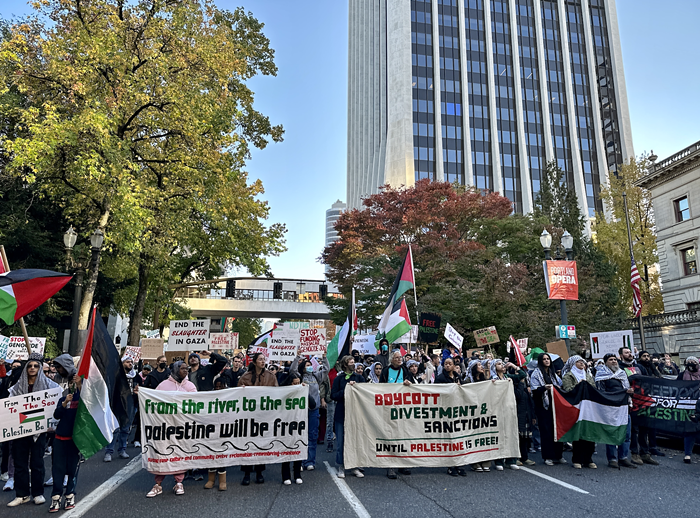SOMEONE AT Hazelnut Grove has been tagging, and it's a problem.
By the time residents of the North Portland homeless camp gather recently for one of their Saturday meetings, the graffitied scrawlings have been popping up for days—always the same word: "Rowdy."
It's not hard to find a suspect. A man named Rowdy set up camp on Hazelnut Grove's fringes not long before. Everyone knows Rowdy.
But Rowdy, for his part, admits nothing.
"He's in denial," a camper named Marvin tells 15 people gathered in the Grove's well-appointed kitchen tent. "But like I told him, ain't nobody else gonna go out and tag your name for you."
There are far more urgent matters, on this day, than Rowdy. Not long before the graffiti issue came up, the weekly "general assembly" meeting nearly devolved into a screaming match over accusations that included knife play, gun possession, drug use, and frequent problematic drinking.

- James Rexroad
The tagging bothers Hazelnut Grove residents just the same. It risks upsetting what scant peace the camp has reached with the Overlook Neighborhood's nearby homeowners—and by extension, jeopardizes the most permissive attitude toward homelessness Portland City Hall's had in years.
"This is a solution," Vahid Brown, the growing camp's most stalwart advocate and mediator of the weekly meetings, tells the group. "Organized tent camping is a viable way to get off the fucking sidewalks."
About those sidewalks: They're packed.
Portland's in the midst of a homelessness crisis worse than anything the city's seen in decades. Each year in Multnomah County, thousands of people fall into homelessness, joining the thousands who are already there. Our system for lifting them up does important work every day, but it can't bail out the boat fast enough.
Outcry over the issue reached new and novel decibels over the summer—to the point that Portland arrived on a new word for its homelessness problem: "emergency."
On September 23, Mayor Charlie Hales surprised city and county officials by declaring that the situation had grown as dire as any earthquake or flash flood—and deserved the same urgency. A week later, Hales and others bathed in applause and skepticism as they announced help was on the way: $30 million to arrive by next July.
The windfall came with a startling suggestion—that it was enough to slash Portland's entrenched homeless problem in half by 2017.
If that sounds too good to be true—it sort of is. It'll take far more than $30 million to see the kind of sustained progress that could keep homelessness at bay here, and Portland's only got so much money to go around.
Still, that $30 million has caused more optimism than the city's seen in years. Even veterans of the homelessness fight are sort of giddy about the money and the plans that come with it.
Now they've just got to put those plans into action.
"It's the most comprehensive and systematic work that we as a community have ever done," says Marc Jolin, who spent decades as an advocate before being tapped by the city and county last year to lead this effort. "If we get all the money we need, we'll know how to spend it."
WANT AN IDEA of how ugly the backlash over homelessness is in Portland?
Earlier this month, Hales and Multnomah County Chair Deborah Kafoury requested a meeting with the Portland Business Alliance (PBA) to talk about the issue and their plans to fight it. The elected leaders were incensed by a recent PBA ad campaign that announced "we can do better than this."
They'd reached a question-and-answer portion of the presentation when one PBA member in attendance spoke up. J. Clayton Hering, the respected chairman of commercial real estate firm Norris, Beggs, & Simpson, shocked some at the meeting by trotting out a suggestion that the city should take homeless people's shoes, and give them one-way tickets to Hawaii.

- Mayor Hales
- Multnomah County
"He was not shouted down by his colleagues," Hales says, "though he should have been."
Hering tells the Mercury he made clear the comment wasn't his preference—that he was just quoting something he'd heard years ago. Hales, his chief of staff, and others who were present say he made no such caveat.
Whatever the case, this repugnant sentiment is perhaps not unique. As homelessness has grown more visible this year, outcry over the issue has followed suit.
There's Fritz Jünker, for instance, a Southwest Portland designer and architect who took up a crusade for stiffer crackdowns after a man grabbed his wife by the hair through their car's sunroof, and wouldn't let go. Jünker began circulating a list of proposals online, and testified before Portland City Council, chiding commissioners over the current state of affairs.
"There are people who need help in this city," he says. "At some point we're going to have to make distinctions about who needs help and who needs a swift kick in the ass."
In the Pearl District, a group of business owners mounted an online attack this summer over camping that was flourishing on the North Park Blocks. The group began posting pictures online depicting drug use and sexual activity—what advertising executive Michelle Cardinal, the coalition's leader, now calls "an occupation."
"When we called the city to complain, no one would listen," Cardinal says. "But when we showed them the pictures, they started paying attention."
Portland's troubles are far from unique. A day before Hales announced he'd seek an emergency declaration, Los Angeles—with its more than 25,000 homeless—became America's first city ever to do so. Earlier this month, Seattle declared its own state of emergency after the number of unsheltered people in King County swelled 21 percent from 2014.
Hawaii's governor declared an emergency in the state in October, not long after the city of Eugene signaled it would ask Governor Kate Brown to put one on the books in Oregon.
"We've tried slow and steady; we've tried by the book," Hales has said of Portland's housing emergency declaration. "It's time to add the tools we currently lack."
This is the environment A Home for Everyone (AHFE) was born into. The group, a collection of more than two dozen social services providers, public agencies, advocates, and elected officials, came together a little more than a year ago under a mandate from city and county leaders to launch a fresh assault on homelessness.
It's been busy ever since.
In recent months, AHFE's scoured data on the county's homeless population, and used millions in federal grants to house the city's homeless veterans (a job the city promises will be finished by Christmas). It's also come up with a set of action plans it says can chop the unmet demand for housing in Portland—homes for more than 4,000 destitute people—in half by the middle of 2017.
No one would blame you for scoffing. Portland's decades-long struggles have birthed a long list of committees, each of them touting a litany of formal plans. Last year marked the end of the city's vaunted 10-Year Plan to End Homelessness, marketed in 2004 as the definitive strategy for eradicating the problem. Yet it persists.
"We shouldn't overpromise," cautions Ed Blackburn, executive director of Central City Concern and an AHFE member who's watched plans blossom and fizzle since the '80s. Still, with new federal and state aid, and the recent $30 million pledge, even Blackburn thinks Portland's got a shot at doing something big.
"I haven't seen all that kind of stuff happening at once," he says. "I don't think we've ever seen these kind of numbers."
A Workable Plan?

- A Home For Everyone
By digging into all available data about Portland’s homeless, A Home For Everyone (AHFE) has concocted a plan it says the city could use to vastly reduce the city’s homeless population—to the point where the problem’s barely recognizable five years from now.
The modeling suggests that by ramping up the number of homeless people placed into housing each year (the yellow line) and pouring more effort into preventing families from becoming homeless in the first place (the blue line), we can drastically reduce the number of people who have nowhere to go (the pink line). That dotted line is the number of people who were placed into housing in 2014, a baseline amount AHFE says can’t meaningfully reduce the city’s homeless population.
If this all sounds obvious, it won’t be easy. The plan would require lots of money—way more than the $30 million Portland and Multnomah County have promised to spend next year—to make it a reality.
THE MOST RECENT ESTIMATES we have of Multnomah County's homeless population—a one-night snapshot from this past January—suggests the problem isn't shooting up at the alarming rates seen in cities like Seattle.
The count found 172 more people were homeless in 2015 than during the last study in 2013. That uptick, from 4,441 people to 4,613, amounts to a four percent increase in two years. But it also includes people staying in transitional housing, who have a roof over their heads.
Plenty don't. The count actually found a tiny decrease in the number of Portlanders sleeping without shelter—1,887 compared to 1,895 in 2013—though the proportion of African Americans, families with children, and women had risen.
The accuracy of these exercises is notoriously tough to gauge, but even if the number of people sleeping on the street did shrink by eight people, it's a defeat.
Last year, Portland was the most successful it's ever been at getting homeless residents into permanent housing—by a wide margin. Thanks to increased spending, the city's social service providers were able to house more than 3,500 people, about 20 percent more than they'd helped the year before. Yet the ranks of homeless still rose, and 56 people died on the streets.
Another bad sign: The city's homeless shelters—which offer between 500 and 700 beds a night depending on the season, according to AHFE's numbers—served 42 percent more people in fiscal 2015 (July 2014 through June 2015) compared to the year before.
"That's an indication that we're seeing more people become homeless," says Jolin. "It's a flag for us that something's happening out there."
The "something" isn't hard to pinpoint in Portland. Rents have shot up more than 15 percent in the last year, while most demographics are still making less than they were before the great recession.

- Multnomah County
"There are so many factors at play," says Kafoury. "Increasing housing costs, low vacancy rates, entire apartment complexes being turned over.
"We're getting hit from all angles."
AS WITH MOST housing policy, AHFE's grand plans for the $30 million in "emergency" money are choked with dull spending ledgers and unhelpful acronyms. Here's an oversimplification:
• $12.5 million will go to dramatically increase the number of people placed into housing—from an estimated 3,700 this year to 4,350 in 2017. That involves not just finding homes for people and helping them pay rent, but offering services (substance abuse treatment, mental health care) to ensure they keep that housing.
• $5 million will go to increase shelter space. AHFE predicts Portland needs 650 more shelter beds for women and people with disabilities—even if it's successful in housing many more of its homeless. The city's shelters currently meet only about half of the demand, and have months-long waiting lists.
• $2.5 million will help prevent 1,000 people from sliding into homelessness in the first place, with things like rent assistance and renters' rights education. Ultimately, this is the Holy Grail for fighting Portland's homelessness crisis, since prevention is much cheaper than pulling someone off the streets. For now, it's a small component.
• $10 million will help develop new housing specifically available to homeless people or people at risk of becoming homeless. That money could be leveraged for millions more in actual construction costs.
The spending plans are a skeleton of sorts, fleshed out with dozens of new proposals around job programs, health care, and housing. As Jolin puts it: "We need the policy changes that make these investments more effective."
AHFE's graphs and models of how these plans would play out in the real world make this all seem simple (see page 13, for example). As more people get into housing, the amount of unmet need for housing drops dramatically. As more money is added to prevent people from becoming homeless in the first place, that unmet need drops even faster.
By 2017, according to AHFE's modeling, the demand for housing does indeed fall by half. If you follow the lines out further—to 2019—it drops down to around zero.
But if the graphs have solved homelessness, Portland still has not. One thing lost in the backslapping over the $30 million pledge is that it's just a one-year disbursement in a plan that will take years of big money before costs begin to taper off. If things go back to the status quo once that money dries up, fewer people will be pulled off the streets the following year, fewer families will be saved from falling into homelessness, and fewer shelter beds will be available.
The biggest question around Portland's latest plan to kill homelessness, then, isn't so much whether it can work. It's whether it will really be given the chance.
The inescapable answer: No one's sure.
Hales, in a conversation with the Mercury, said he'd press to get some funding for AHFE's initiatives replenished every budget cycle—and he recently had a hand in dramatically increasing money for affordable housing in the next decade (at least in theory). But the mayor's also pushing responsibility elsewhere—to state legislators who might make cheap apartments more easy to mandate, for instance, and to Portlanders, who may be asked to vote on a new revenue stream for housing next year.
At the county level, Kafoury's also uncertain how far this all goes.
"There will be another shiny object in the years ahead," she says. "That's why I'm putting myself into this issue now. It's not what can we do in 10 years—it's what can we do next year, or in two years?
"Just because we may not succeed is not a reason not to try."

IRONICALLY, the immensity of Portland's homelessness crisis is a blessing for Hazelnut Grove, that North Portland camp fretting about Rowdy.
If not for the outcry and the emergency declaration, the camp probably wouldn't be allowed to exist. Without the input of advocates and experts at AHFE—many of who support temporary organized tent camps—its 40-plus residents might have already been swept, like so many homeless people in Portland have been under Hales.
It's entirely possible Portland's never been so primed to try new strategies to ease its homeless problem—and the men and women of Hazelnut Grove are keen on keeping hold of their good fortune.
At their weekly general assembly meeting, as tensions rise over all-night drinking and discord, Raven Justice, a founder of the encampment, silences the bickering with shouts of his own.
Justice, like so many others in the camp, has no better option than this. As with every segment of Portland's thorny crisis, so much is on the line.
"I can't go anywhere!" Justice tells his campmates. "If anyone ends up screwed if this camp gets closed down, it's me!
"I cannot allow anybody to risk where I am."













